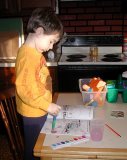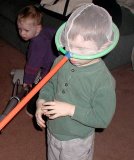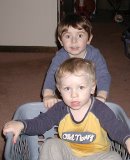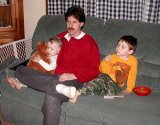
I wrote an entry about finding a Consultant and then lost it earlier today, and I'm sort of glad. Gives me a chance to do it better this time. The first time I just told the story of us finding an RDI Program Certified Consultant. But the more interesting topic to write about is WHY you would want to find one. I mean, professionals are expensive, and there's plenty of free information on the Connections Center website,
http://www.rdiconnect/com, plus all the free Yahoo RDI e-groups, blogs, etc, as well as a couple of books written on the topic. Certainly it's possible to make progress on your own?
Well, yeah, it's possible. In fact, probable. We did it -- we had mastered stage 1 by the time we went to our RDA (Relationship Development Assessment), about 6 months after starting RDI on our own, and had already seen AMAZING progress. But it wasn't until we started working with our consultant that our program really kicked into high gear. Would we have kept making progress if we never started with a consultant? Probably. But I don't think the quality of our program would have been as deep or effective, nor would our progress have been as "fast" as it has been. It's one thing to read about how to "do" RDI, it's quite another to watch someone well-versed in it interacting with your child. My understanding of the process jumped exponentially during our RDA, and the support, advice, and having someone that HAS to listen to you (because you're paying them -- I'm only half-joking with this!) has made it worth every penny.
Ok, so why would an otherwise intelligent person (that's me, by the way, and probably a lot of you reading this too -- the rest of you are probably already working with a consultant!) need to hire a professional RDI Consultant?
1. To administer the RDA, so that you know what has been mastered and what still needs to be worked on. In the beginning, maybe this isn't as vital -- pretty much everyone starts at Stage One (and I'll talk more about the stages in an upcoming post). But once you start to get rolling, it's easy to get lost as to where exactly you are in the RDI program and what needs to be worked on before moving along to the next Stage. Having those basic building blocks in place and mastered certainly leads to a smoother road. Without it, potholes crop up and you end up having to stop and fix them at some point before being able to regain momentum again. The whole thing just runs much smoother under the experienced guidance of a Consultant.
2. So that someone emotionally outside of your family can look at what you're working on and tell you where you're screwing up. They'll tell you where you're doing good, too, but you probably already know THAT. It's the screwups being pointed out that help you learn and are the nudge you need to push you back onto the travel lane when you've drifted off into the shoulder of the road. And the Consultant prevents you from coasting, too, which will happen if you're not providing enough challenge, by telling you to increase the challenges you present. They also check your speed to make sure you're not going to swerve out of control and cause a wreck by providing too much challenge all at one. It may seem like a pretty "duh" moment when they point something as simple as "that was too challenging for him, try scaffolding a bit more" while viewing a video tape of your wild screaming child, but without the reminder, you just may keep kareening down the road with the pedal to the metal.
3. To act as a personal sounding board when you are frustrated, or feel like you just can't go on, or that you're not making enough progress, or that the whole thing is just too overwhelming. They help calm you, they keep you focused on the important goals, they remind you of what you've already accomplished. They provide support that nobody in your family or circle of friends can, because they truly understand. And they have a clientel full of other people on the same journey that they can hook you up with for real-life moral support. Many consultants host support groups for their clients.
4. To interpret all of Dr Gutstein's professional-ese babbling. Don't sell this function short. Dr. Gutstein has a totally brilliant mind, but I sometimes think that we mere mortals need a formal interpreter to understand the extent of the content he's trying to provide to us. There's been more than one email to our Consultant that has started by saying "What the heck did Dr. G mean when he said ..... on Tuesdays' chat?"
5. Related to #4, the Consultants are required to keep up with all of the latest RDI information. Because this is such a "new" and constantly evolving therapy, and because it's kept on the cutting edge of Autism research, it seemingly shifts on a daily basis. A Consultant can keep you abrest of all the lastest information and RDI news.
6. It's an AMAZING bargain compared to the vast majority of other therapies available, all of which are less effective at actually remediating Autism. I'm not going to lie, it ain't cheap. But it's less expensive than all of the other options I've run across. And the dollar spent per benefit gained ratio doesn't even compare. I like a bargain.
7. By working with a Consultant, you get access to the Annual Parent's Conference (which I posted about previously), which is an amazing opportunity to commune with hundreds of other fellow RDI-ers in person, not to mention the chance to attend workshops and lectures with some of the key people in RDI and Autism Remediation, on the cutting edge of progress. It's just too cool.
8. I left this one for last, because it's the most controversial. With the new RDI operating system, which will be launched at some point during 2007, you will need to be working with a Consultant in order to have access to the system. There are a couple of reasons for this -- first is because this form of detailed computerized tracking allows the Consultant to pick and choose the objectives you are working on (choosing the most appropriate, ignoring the rest), rather than you sitting there with all 1600 RDI Program objectives in front of you wondering where to go from here. The system will increase the effectiveness and efficiency of Consultant/Client communication, but you NEED this relationship with a professional in order for it to work. The other reason is simple Quality Control -- this is a way for the Connections Center to make sure their Consultants are practicing up to their high standards -- in other words, that they are truly representing the RDI program, and not some modified or water-downed version of it. There are bound to be "professionals" that call themselves "RDI Consultants" who work with clients in an RDI-type fashion of some sort, and no doubt some of them will have some amount of success. But I as a consumer would like a way to make sure that I'm really getting what I pay for, and I think this is a great way to ensure that.
Some people will argue that the Connections Center and Dr. Gutstein are trying to shut out people who can not afford to hire a Consultant, but I just don't believe that's the motivation behind this move. I think that Dr. Gutstein is very concerned that RDI is available to everyone that wants to use it. Certainly, people will continue to "do" RDI on their own and will continue to see results, just like they are now. But for those that want "something more", there are RDI Program Certified Consultants to help.

 You'll notice that I put off writing this for a good week or so. The emails are still trickling into my inbox -- how much does an RDI Program Certified Consultant actually cost? Exactly how much money are we talking? It's not an answer I'm anxious (or qualified!) to provide, as I am NOT a consultant. But, here goes anyway.
You'll notice that I put off writing this for a good week or so. The emails are still trickling into my inbox -- how much does an RDI Program Certified Consultant actually cost? Exactly how much money are we talking? It's not an answer I'm anxious (or qualified!) to provide, as I am NOT a consultant. But, here goes anyway.




